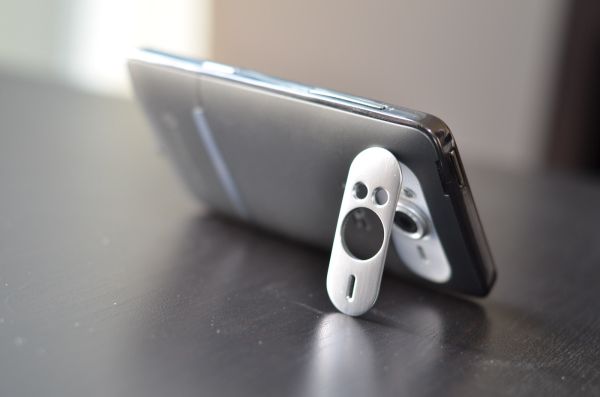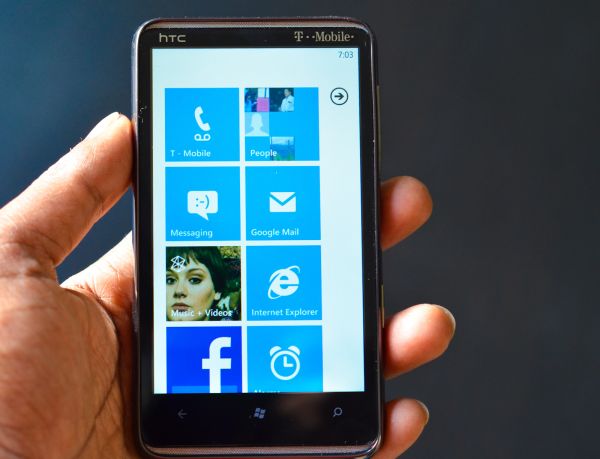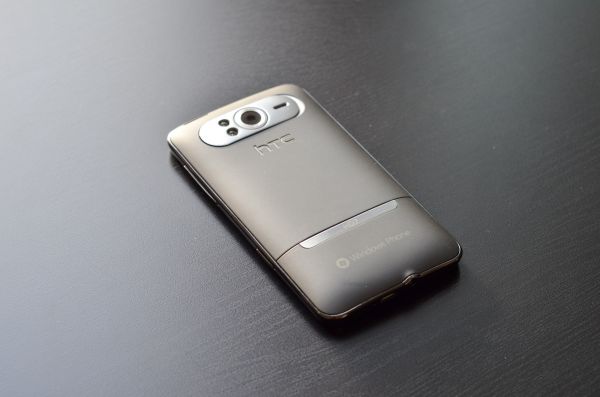HTC HD7: Now With NoDo
by Vivek Gowri on May 12, 2011 6:30 AM EST- Posted in
- Smartphones
- Windows Phone 7
- Snapdragon
- Mobile
- HTC HD7
When Microsoft launched Windows Phone 7 late last year, it was readily evident that they had a solid platform on their hands, but it was missing some critical details. Chief among them? Copy-and-paste, bringing back a frequent grievance from the early iPhone days. The platform’s first update, codenamed “NoDo” (there’s a story behind that), is now out, with copy-paste support in tow, along with much improved application loading and some general performance tune-ups in the UI.
At the same time, we decided to take a look at HTC’s HD7, since it’s been my day-to-day phone for a couple of months now. It’s still the only Windows Phone you’ll find in a T-Mobile store, so it’s worth taking a look at, especially now that a very similar variant is due to hit AT&T in the coming weeks.
Meet the HD7
When HTC launched the HD2 in late 2009, it was one of the most technologically advanced phones on the market, with a 800x480 4.3” display and a 1GHz Qualcomm Snapdragon processor. This was well before everyone had a 1GHz phone—the HD2 was just the second Snapdragon-based device to hit market, after the European Toshiba TG-01, and was the first 1GHz phone on the American market. Unfortunately, for all the amazing hardware, it was saddled with Windows Mobile 6.5. Even with HTC’s advancements to WM (capacitive touch, multitouch, the first implementation of Sense UI) it simply wasn’t a viable platform at the time. A good comparison would be the N8—great hardware running a dead-in-the-water OS.
When Microsoft started releasing details about Windows Phone 7, it became clear that while fully capable of running the new OS, the HD2 would not be getting an upgrade. Microsoft indicated that the button layout did not conform to the guidelines given for WP7 handsets, which was true, but Microsoft really wanted to have a clean break from the previous generation of products, and that left the HD2 in a cold place (officially, at least—XDA and other developers have gotten everything from Froyo to WP7 to Ubuntu and Windows XP running on the HD2). HTC did the next best thing, and relaunched it’s flagship Windows device as the HD7, with 7 indicating it’s status as a WP7 device. In the process, it got a mild ID refresh and a few more features, but overall, it’s very, very similar.
The first noticeable difference is the buttons—the five button array has been replaced by three backlit capacitive buttons—back, Windows, and search, as dictated by the WP7 design guide. The speaker and mic have been expanded to span the width of the device at the top and bottom edges, with an attractive metal grille covering them. The matte plastic on the sides of the phone has been replaced with a dark chrome band, which has an attractive but understated look. It’s much more subtle than normal chrome brightwork.

The curved back of the HD7 is rendered in a mildly rubberized plastic, with a brushed aluminum stand surrounding the camera. The stand, while a clever detail, is not actually that great—like the EVO 4G, it’s prone to tipping over if not on a perfectly level surface, due to the location and shape of the stand itself. I like the Thunderbolt’s stand better, it’s sturdier and works in both portrait and landscape modes. But the biggest problem here is the battery cover. The soft touch plastic is great, but the cover itself feels cheap, and for good reason. The plastic itself is ridiculously thin, and there are large panel gaps—with the battery cover mounted, you can actually see a bit of the SIM card. In addition, the panel gaps let in a lot of dust. It’s a blemish on an otherwise well designed device.
The interesting part hidden in all this is that given HTC’s current lineup, the HD7 feels a little bit last generation. HTC has moved to a very consistent design language across all of it’s devices, as noted by Brian in his Thunderbolt review. It started with the Desire HD, which was an update of the Nexus One/Desire industrial design, and HTC has since expanded the design language to (long list alert!) the Mozart, the Surround, the Trophy, the Thunderbolt, the Sensation, and the Desire S (or the Incredible S for VZW). The HD7 is a holdover from the old days, when HTC had more slab sided designs, with less curves and less metal. Most of the recent HTC designs have basically pointed towards aluminum unibody construction, and the HD7 unashamedly differs from that. I’d expect the next revision of the HD7 to fall much more in line with the rest of HTC’s recent phones, possibly based on the Desire HD chassis.
| Physical Comparison | |||||||||
| HTC HD7 | HTC Surround | LG Optimus 7 | Samsung Focus | Dell Venue Pro | |||||
| Height | 122 mm (4.80") | 119.7 mm (4.71") | 125 mm (4.92") | 122.9 mm (4.84") | 121.0 mm (4.76") | ||||
| Width | 68 mm (2.68") | 61.5 mm (2.42") | 59.8 mm (2.35") | 65 mm (2.56") | 64.4 mm (2.54") | ||||
| Depth | 11.2 mm ( 0.44") | 12.97 mm (0.51") | 11.5 mm (0.45") | 9.9 mm (0.39") | 14.9 mm (0.59") | ||||
| Weight | 162 g (5.71 oz) | 165 grams (5.82 oz) | 157 grams (5.54 oz) | 119 grams (4.2 oz) | 176 grams (6.21 oz) | ||||
| CPU | 1GHz Qualcomm QSD8250 | 1 GHz Qualcomm QSD8250 | 1 GHz Qualcomm QSD8250 | 1 GHz Qualcomm QSD8250 | 1 GHz Qualcomm QSD8250 | ||||
| GPU | Adreno 200 | Adreno 200 | Adreno 200 | Adreno 200 | Adreno 200 | ||||
| RAM | 576MB LPDDR1 (512 system, 64 GPU) | 512 MB LPDDR1 (448 system, 64 GPU) | 512 MB LPDDR1 (448 system, 64 GPU) | 512 MB LPDDR1 (448 system, 64 GPU) | 512 MB LPDDR1 (448 system, 64 GPU) | ||||
| NAND | 16GB integrated | 512 MB integrated, 16 GB (Internal Class 4 microSD) | 16 GB integrated | 8 GB integrated | 8 or 16 GB integrated | ||||
| Camera | 5MP with autofocus, LED flash, 720P video recording | 5 MP with autofocus, LED flash, 720P video recording | 5 MP with autofocus, LED flash, 720P video recording | 5 MP with autofocus, LED flash, 720P video recording | 5 MP with autofocus, LED flash, 720P video recording | ||||
| Screen | 4.3" LCD 800 x 480 | 3.8" LCD 800 x 480 | 3.8" LCD 800 x 480 | 4" Super AMOLED 800 x 480 | 4.1" AMOLED 800 x 480 | ||||
| Battery | Removeable 4.55 Whr | Removable 4.55 Whr | Removable 5.55 Whr | Removable 5.55 Whr |
Removable 5.18 Whr |
||||
At 162 grams (5.7 ounces), the HD7 is a pretty hefty phone, and the size and weight give it a substantial feel in-hand. Battery cover notwithstanding, it feels very well put together and very familiar at the same time. The HD7’s similarities with the EVO and HD2 are not just limited to physical attributes; all three share variants of Qualcomm’s first generation Snapdragon SoC. The GSM-only HD7 has the QSD8250, as with all other WP7-based handsets, to go along with 576MB RAM, 512MB ROM, and a built-in 16GB SD card. It’s no longer cutting edge, but Microsoft is fairly limiting as far as what they allow handset makers to use—you can get a WP7 device with any CPU as long as it’s a 65nm Scorpion, Ford Model T-style. We’ll get to the application performance in a bit, specifically the NoDo update and the performance improvements it brings, but for now, let’s take a look at the display and camera performance.


















44 Comments
View All Comments
softdrinkviking - Thursday, May 12, 2011 - link
nice clip vivek. :)i am interested in WP7, but i am totally underwhelmed by the weak hardware, especially the displays!
basically, a phone is like 90% display, and it seems like apple is the only company that gets that.
but i am not huge IOS fan.
i am going to be back in the US at the end of June after working overseas for 3 years, so i am really hoping that something awesome comes out by about then. (droid 3 maybe?)
sviola - Thursday, May 12, 2011 - link
I know everyone here is a hardware enthusiast, but I don't think it is a major problem with WP7, that seems to run very well on the current hardware, in terms of processor and memory. Of course there is room for improvement and I could add a few examples: cameras, 4G, front facing camera, removable flash storage, multi-SIM; but this will probably come with the Nokia handsets (seems their first handset will be built with the N8 as reference, so we will get 12 mp camera and many other nice stuff).As for the software, there is a need to improving it and I'm sure that with Mango we'll see a lot more than has been disclosed so far:
- Multitasking
- IE 9
- Twitter integration
- Turn by turn navigation
- Voice to text
- Bing Audio
- Bing video
- Messenger integration
- Unified Inbox
- SkyDrive sink for Mobile Office
- Skype
Of course, we'll have the complete list on May 24th when they'll show it to the press.
Silent_Rage - Thursday, May 12, 2011 - link
To say that WP7 runs well on last generation hardware is an understatement. I currently have an HTC Arrive (gotta have the keyboard) and while there are features I wish it had such as front-facing camera and 4G, I really enjoy using it. I got one for my wife and the best part was that she didn't need me to show her how to use it....she figured it out herself!! I think that WP7 has a lot of promise, but I agree with Vivek that the update cycle must be more aggressive to catch up with the competition. From what I read about Mango, it looks promising but they cannot afford to delay this update like what happened with NoDo.softdrinkviking - Thursday, May 12, 2011 - link
the only thing i really want is a better display. that's it. processors they have are good enough to do what i want for the most part, but i would really like a nicer, crisper, display, and hope against hopes, one that is easy to read outside!damianrobertjones - Thursday, May 12, 2011 - link
I don't think that removable storage is a sensible thing. We used to have people here who simply didn't 'get' removable micro-sd storage back in the 6.5 days and neither do many of the people out there in the street. If it works for apple then I say 'don't' have removable storage as you open the company to complaints. People will also buy MEGA cheap cards and THEN complain of speed issues.FrederickL - Friday, May 13, 2011 - link
I have to say that I really disagree. I do not see why my choices should be damaged by the brain-dead amongst the customer base. I have some respect for what MS are doing with Win7 and will definitely be interested when Nokia start delivering. If however there is no removable storage (and they continue like other companies with non-removable batteries) that will be a total deal-breaker for me. MS are clearly running hard to catch up on the software front but if every new release of a WP7 is more of the same old same because Redmond refuse to lighten up on the hardware restrictions, I for one will not even bother to look at a Windows phone.
xype - Thursday, May 12, 2011 - link
iOS 5. :Pxype - Thursday, May 12, 2011 - link
Damn, should have been a comment to softdrinkviking… anyhow, the hardware will get its updates—if WP7 looks like an interesting alternative, I wouldn't worry too much about the hardware part.Psycownage - Thursday, May 12, 2011 - link
As always a great review from ananndtech however i have noticed a couple of problems with the graphs, first on battery graphs 2 are identical, looking at image links i guess one of these should show talk time. second, shouldn't black levels be lower is better not higher is better?VivekGowri - Thursday, May 12, 2011 - link
Fiiiiixed, thanks for catching!